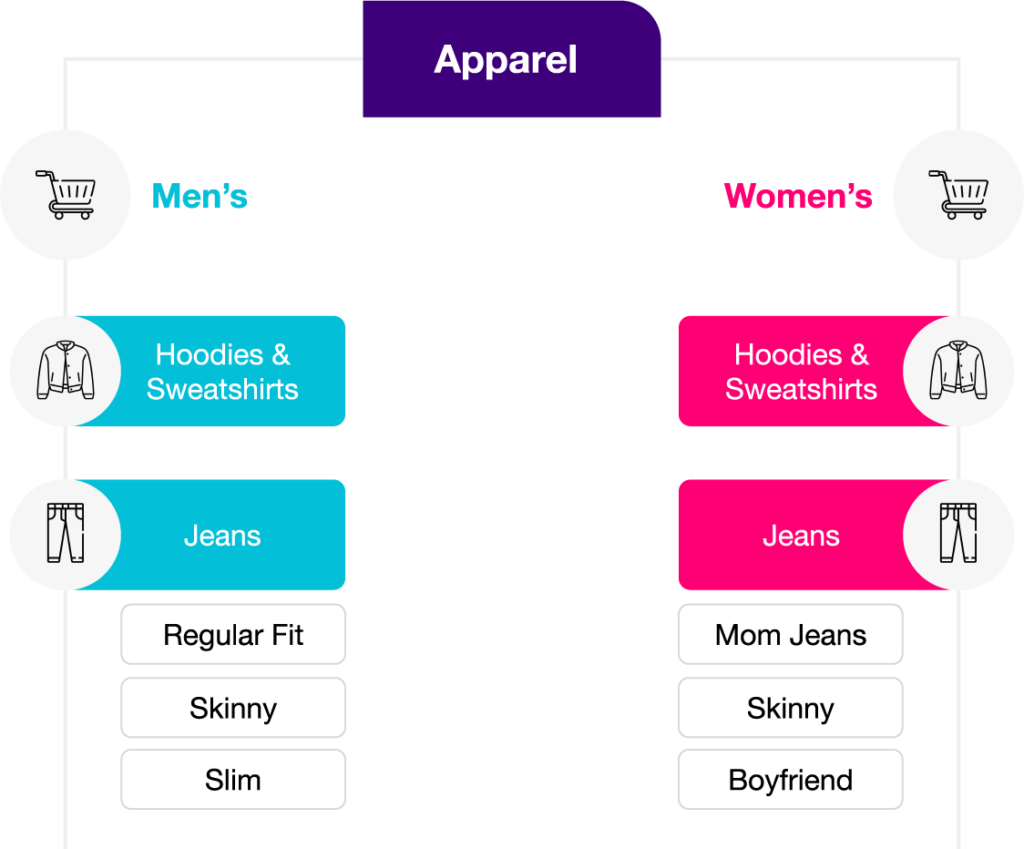Industry Knowledge
Boost Online Sales with Ecommerce Product Categorization
Having a well-organized and strategic product categorization process increases value to your eCommerce business.
Customers shop online for one key reason—convenience. But as easy as online shopping can be, you can instantly lose customers if you don’t structure your eCommerce business properly. But how?
Product categorization is the blueprint of convenient online shopping, helping customers navigate eCommerce stores with ease. Like how grocery stores group items according to respective aisles, eCommerce stores should also have an organized system to help customers quickly get what they need and want.
In recent years, smart retailers have implemented AI-based product categorization systems to automate retail operations and enhance the customer experience. In this article, we’ll go over what product taxonomy is, the benefits of implementing it, and how to get started.
What is Product Categorization?

When browsing through an eCommerce website, where do you begin? For example, when shopping for shoes, we often start by navigating different categories—for men, for women, or for children. The online shop’s search engine narrows your selection from women’s shoes to heels, boots, sports shoes, and more. This customer journey illustrates how product categorization works.
Product categorization, also known as product taxonomy or eCommerce taxonomy, is the classification of products into distinct, hierarchical categories. Ecommerce product category hierarchy is based on their characteristics, features, and attributes.
While this process may seem simple, a product may fall under multiple categories depending on how many variations there are. They can be divided into broad categories that branch into more specific subcategories.

A comprehensive categorization of products makes it easier for customers to add to their carts and keep discovering new items, resulting in increased sales for your eCommerce business.
Benefits of Ecommerce Product Categorization
Aside from improving the overall customer experience, eCommerce taxonomy brings multiple advantages to the overall business operations.
- Improves Conversion
Accurate product taxonomy helps customers intuitively find what they want on your eCommerce site. It can also help customers discover new products they might not have considered. A disorganized storefront may cost you customers if they take too long to find what they’re looking for.
- Boosts Website Traffic
Website visibility is crucial to driving traffic to your eCommerce storefront. A clearly defined web architecture and properly categorized catalog help boost SEO and improve search relevance. Categorizing products makes it easier for search engines like Google to crawl your site and index pages faster. Having multiple entry points or landing pages helps bring in more traffic, especially if you also employ other SEO tactics, such as adding keywords to alternative image text.
- Enhances the User Experience
These days, many retailers are taking advantage of AI-based product classification, which can recommend new products based on a customer’s browsing and purchase history. Personalized content based on their individual preferences can further boost your storefront’s bottom line.
- Streamlines Operations
Proper product categorization also helps streamline the operations of an eCommerce store. When products are organized into clear categories, it becomes easier for the store to manage its inventory, process orders, and make data-driven decisions.
How to Categorize Products for eCommerce
To increase sales and add value to your business, product categorization should be done correctly. Here are three major elements to create an effective eCommerce taxonomy:
- Categories & Subcategories. This refers to your site’s framework—the hierarchical grouping of product categories, moving from a few broad groups to smaller subcategories.
You can typically see these represented in the following format:
Your product category hierarchy should have names that are clear, concise, and easily comprehensible. Avoid using technical jargon or industry terms that may be unfamiliar to customers
- Attributes. Each product should have several attributes to describe it further. These attributes typically cover features, properties, or product characteristics, such as color, brand, size, and more. Attributes are used to refine product categorization and help customers find the specific products they are looking for.
- Values. Each product attribute should have a list of possible values. For example, values might be red, blue, or pink for attribute color. For size, values are small, medium, or large. Having values makes it easy for customers to sort pages and find what they need.
To identify the key elements of product taxonomy in your business, start with your customer’s perspective. Know who they are, what they want, what they could buy in the future, and how they want to navigate your shop.
AI-powered product categorization tools can help automate and streamline the process, saving time and improving the accuracy of personalized content. However, when done in-house, the back-end process can be costly, tedious, and time-consuming. If you need more resources or knowledge, opt for eCommerce outsourcing, such as solutions from data labeling companies that have the expertise and technology to power automated product taxonomy.
Outsource Product Categorization Services to TaskUs
Interested in product categorization but need help figuring out where to start? That’s where data annotation companies like TaskUs come in.
Recognized by the Everest Group as the World’s Fastest Business Process (Outsourcing) Service Provider in 2022 and highly rated in the Gartner Peer Insights Review, TaskUs offers tech-enabled outsourcing expertise in various industries. We partner with the most disrupting companies to provide cutting-edge customer experience solutions to our valued clients.
Through our proficiency in AI Services and Retail and eCommerce, we provide data annotation services, audio transcription, and data collection services to power automation for eCommerce businesses, including product catalog management. Our team of experts has extensive experience in eCommerce product categorization to help you add metadata to your product catalog.
With access to a talented, diverse, and global workforce, we can quickly recruit, train, and manage teams of any size to cater to your specific requirements.
References

We exist to empower people to deliver Ridiculously Good innovation to the world’s best companies.
Useful Links








